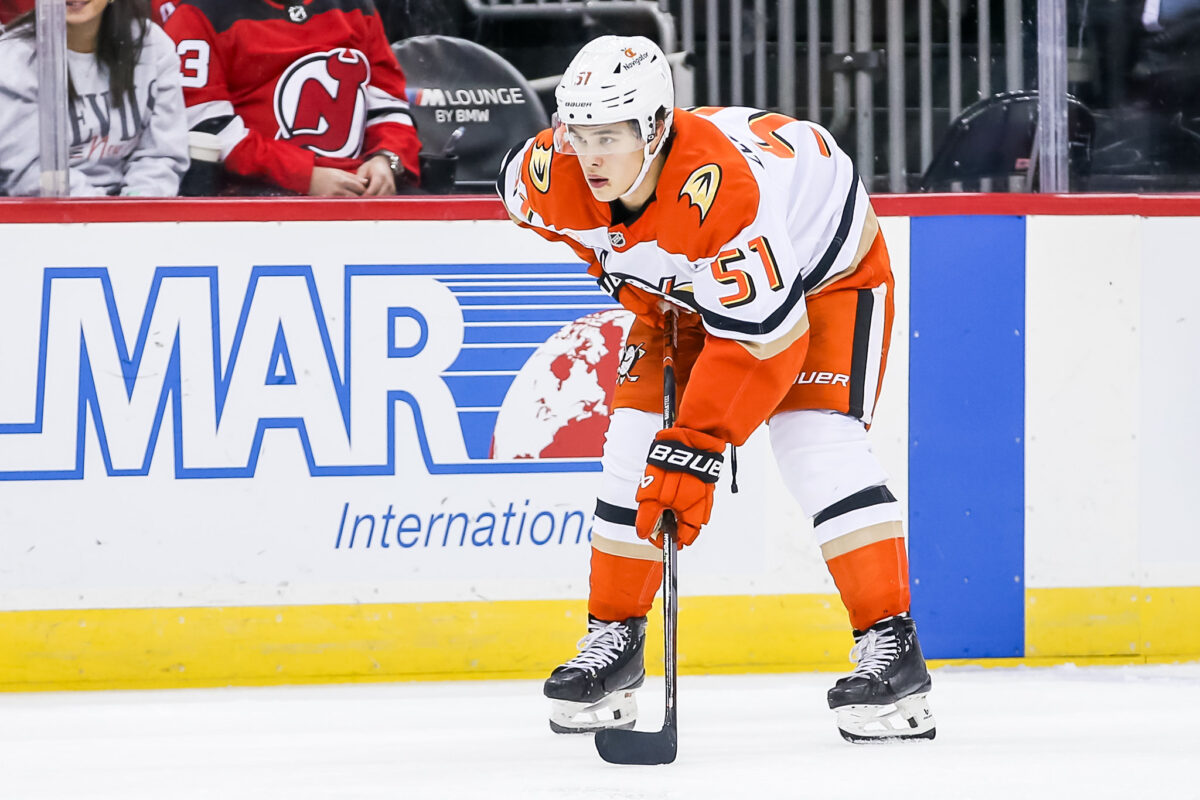The Anaheim Ducks are near the end of their season-long homestand during which they have gone 1-4 and scored 11 goals. Their most recent loss – a 3-2 defeat to the Vegas Golden Knights (Nov. 13) – was typical Ducks this season in that they suffered mightily from costly turnovers, a nonexistent and nonthreatening offensive game, and a sizable gap in puck possession.
A lack of results over the first 30 days of the season is troubling and where the Ducks go from here, or how they improve, is a serious question without a definitive answer. Let’s look at what has gone wrong so far and try to point out one or two things that have gone right.
The Ducks Don’t Have a ‘Top Six’ Right Now
Many who watch or cover the Ducks, me included, expected this offense, particularly the presumptive top six forwards, to give this team a chance to win games by using their mix of creativity, grit, and skill to consistently produce. The precise opposite has been true.
Related: Ducks’ Bottom-Ranked Offense by the Numbers
Trevor Zegras is a shell of himself. Whether it’s the system, players adjusting to him, or something else, he just simply is no longer his creative and playmaking self. Skating was never his best quality, but that didn’t matter because he used his puckhandling, adept passing, and hockey IQ to stand out. He has hardly exhibited any of that through 15 games.
While it is true that an offensive scheme plays a factor in a player’s ability to produce, it should not be wholly responsible for a complete lack of production, energy, or desire to be a leader on the offensive end, like it seems to be for Zegras. He has three points (one was an empty-net goal) this season. He is not converting the chances he does get to score either, and is off to a worse start in 2024-25 than he was in 2023-24, when he came in physically compromised by a shortened training camp. I posited that his renewed health, offensive creativity, and playmaking ability made him a candidate to be a point per game player this season in Anaheim. How awful is that prediction looking like right now?
Similarly, Mason McTavish has been disappointing. He hasn’t cleaned up his discipline (leads the Ducks in penalty minutes) or improved in the faceoff circle. Don’t let his stats fool you – his two goals have come in the final seconds of play in games that were already decided, same with Frank Vatrano, who scored an empty-net goal early in the season and one goal with 12 seconds left in the loss to Vegas. These two were the most consistent Ducks last season when healthy. Vatrano competes hard and puts pucks on net, but McTavish isn’t winning battles or playing with the jump that one might expect out of a 21-year-old player that could be in line for a big payday this summer if he puts up good numbers. To make matters worse, he’s sat out two straight games with an upper-body injury. Alex Killorn, another player lucky enough to be gifted top six forward minutes, has two goals, one of which is an empty netter.
Consider this for a second – the unexpected list of players that have as many or more goals than the players I just mentioned: Brock McGinn, Isac Lundestrom, Robby Fabbri, Olen Zellweger, Ryan Strome, and Pavel Mintyukov. For a team that went into the season with the expectation that it would be led by its young playmakers, the exact opposite has been true. It has resulted in new line combinations (at even strength and on the power play) nearly every game in a desperate attempt to get anyone going.
Not even head coach Greg Cronin, who implemented the system that this team plays, knows how to address their offensive struggles. He preaches all the right things – high compete, two-way play, shot volume over shot quality – but it’s not working. This team’s creativity is suppressed, they can’t sustain possession, and they rarely get the shot volume that he preaches about. Granted, in a league of strong, big, and physical adult men, a young team like this is not going to pick teams apart with offense, but this attack is so bad it seems that Cronin would be better off turning these young players loose and getting into track meets than remaining with the status quo. It would at least be more fun to watch.
Special Teams Are an Eye-Sore
A lack of success on special teams was an Achilles heel for the Ducks last season and continues to be the case this season. They own the NHL’s second-worst power play percentage (PP%) at 11.8% and fourth-worst penalty kill percentage (PK%) at 70.7%. While it’s not special teams related, they also rank last in faceoff win percentage (FOW%) at 42.7%. All three figures are painstakingly bad.
Cronin has mentioned many times that a power play experiences ebbs and flows, and that it can create offensive momentum and confidence even if it doesn’t score. He said it as recently as Wednesday (Nov. 13), following the Vegas defeat. But when have we seen that? More often than not, the Ducks power play units look lost, out of sync, and doesn’t actually generate momentum. It’s a wonderful sentiment by Cronin, but at a certain point you have to care about converting power play chances. Merely stating that a power play course corrects itself over the course of a season is not an advisable approach to your team’s power play woes, especially when it is this poor. It needs to start scoring immediately.
Terry, Carlsson, Dostal, Zellweger Are the Lone Bright Spots
No team, no matter how bad it’s playing, is without its bright spots or reasons for optimism. The Ducks are no different as they have a handful of players in each phase of the game that have performed admirably in the early going.
Offensively, it’s Troy Terry and Leo Carlsson. Both of them have tailed off slightly after a terrific start, but both have been offensive drivers with their speed and ability to create plays and scoring chances either for themselves or others. They co-lead the Ducks in goals this season with five apiece, which accounts for 30% of the team’s total goals so far. If the Ducks stand any chance this season, Terry and Carlsson will not only need to keep it up but also get much-needed help from their teammates.
Defensively, Zellweger has separated himself from his fellow young blueliners. His four points (two goals, two assists) aren’t dramatically better than the others, but he has played with poise and energy all season long. He doesn’t take any shifts off, is always looking up ice, and can really zip the puck around. He’ll only get better with time, and it wouldn’t surprise me to see him emerge as the best young defenseman of the bunch by seasons end.

Finally, Lukas Dostal has been superb in net, handling 12 of the Ducks’ first 14 games while John Gibson recovered from an emergency appendectomy. He led the NHL in several goaltending categories in October, but he too has regressed after a series of four straight outings where he has surrendered at least three goals. Generally, he has stood tall in the face of relentless offensive pressure from his opposition, offering some optimism that the post-Gibson era in Anaheim’s crease is bright.
Help Needs to Come From Within
The old sports mantra of “your best players need to be your best players” is perfectly appropriate here. This hasn’t been the case so far, but it’s not too late for Zegras, McTavish, and the others to turn it around. If they don’t, then the Ducks will dig themselves into an insurmountable hole and general manager (GM) Pat Verbeek’s expectation that this team play competitive, playoff-like hockey as soon as this season will start to look like one of the worst assessments of a team by its GM in a long time.
This unit of players is better than this, and they should want better. Hopefully their play starts to reflect it. Their next chance to begin righting the ship is tonight against a beatable opponent in the Detroit Red Wings. Puck drop is 7 PM PST at Honda Center.















